Ok onto the next part. Finishing off the Thursday night seminar Greg showed us a basic jumping sequence that illustrated one of the strongest proofs for testing your dog’s understanding of front cross cues. Below is the sequence; (Again don't forget that all these diagrams below can be enlarged by clicking on them)
If you can lead out to where the asterisk is and guide the dog’s path to you simply by raising and changing your arms your dog has a solid understanding of the front cross cue. We didn’t put it up but it is definitely one I will try in the future. Oh and by the way Greg doesn’t walk the line around the jumps he wants the dog to take when he leads out he just takes the shortest, straightest path to his lead out position, because (as he said) he is confident his dog understands his body cues well enough that when he gets out there the dog is going to be responding to his signals not trying to take his path that he just walked out with. Next was the discussion of pull throughs. He drew a diagram for us like the one below;
This sequence could work either as a 270 or as a pull through. I had never even conceived of there being a 270 like manoeuvre in this one yet when the path was drawn and you imagined the typical 270 but just flatter it most certainly does use the 270 cues. The pull through enters the picture when the 3 is on the bottom side of that jump. This is where you become aware of that blind cross line you carry with you, can visualise the refusal plane of the obstacle and can see your active line rotating with your own body positional cues. The three key aspects of the pull through are that 1) It is more static than a serpentine (ie you will plant yourself or stand still at one point even if just for a millisecond) 2) You turn your feet 3) The picture you see through the uprights is different from that of a Serpentine situation. For 270’s Greg would use his verbals to get the nice tight turn and he said he’s seen it work equally well when handlers teach their dog to ‘dig in’ on the turn (ie take more shorter strides and fight to get in close on the turn). I think this ‘dig in’ cue is well worth some attention even if like me, you may have to cop some refusals due to your body positioning not being absolutely perfect, I use the verbals of “get in, get in, get in” when I want Raven to get close to me on a turn, the issue I’ve had with it is if I am not right next to the upright she ‘gets in’ brilliantly to the point where if she sees a gap between me and the jump upright she’ll get in on my leg beautifully without doing the jump! Can’t not reward because she did as I asked too perfectly!
A nice quick drill for working the pull through is shown below;
It is interesting when Greg talks about his most basic foundation drills for handling, most of the skills you are working on are only performed once in the short sequence. I think this comes from having the goal of perfecting such a move at flat out speed first before trying to combine more than one skill or one repetition of the skill into the one sequence. It is perfected by endless repetitions. I get the impression that this box work really is like having to practice your scales for piano, having your dog’s full attention for duration on heelwork patterns for obedience, or knowing your times table for maths; they are basic skills that need to be perfected at the simplest level before you try to test those skills under more complex situations. This is discipline I have a healthy respect for and certainly aspire to but by the same token I don’t know a single competitor in
Finally for that Thursday night workshop Greg spoke about rear crosses and how you must have them well trained if you are to be successful in agility. He mentioned how so often evil arms come into play and verbals interfere with the smooth, good performances of the rear cross. If your dog has been trained well in the rear cross then all it should require of you as a handler is just to step across the dog’s path as you run behind it. That in itself, should be enough to let the dog know we are turning. He trains the recognition of this positional cue from a very early age by simply having the dog sit in front of you. You have the maximum amount of treats in both hands, as you step across the dogs line behind it the dogs head will turn to follow you, you feed as soon as you see that response with the hand nearest to the dogs head. Then go the other way. Repeat that for two 5 minute sessions each day and you will have put a strong foundation down for the understanding of the rear cross. A very simple, basic exercise that relies only on the dog being able to sit and being food motivated. Before the night ended someone asked about his directional verbal cues for left and right. He placed the following diagram on the board very quickly;
Greg said if the handler can stay in one spot to the right side of jump 1 and turn in a full circle three times in a row yet on the third time give the verbal cue for the dog to go left and the dog does it then your dog is fully proofed on his directionals. As far as Greg is concerned directionals are only there to get him out of a ‘deep shit’ situation on course where he has been unable to get to where he needs to be and they should be so well trained that they over ride the physical body cues for the dog (why else would he use them if they are only there to get him out of trouble). In other words the dog should on a verbal direction cue, follow it regardless of what your body cue is telling it to do. Can’t say I’ve seen too many of those dogs! So that, in as big a nutshell as you’ll ever find, is that for the Thursday workshop one. My only criticism so far was that for the working spot owners, you felt like you wanted some more individual feedback on your performance and what you needed to do to fix up your particular issues, most of us had footwork, timing and poor diagonals on the front crosses.
Seminar 2 – Friday morning Advanced masters handling, again we had 12 working spots with just about all dogs there having their Masters titles or nearly there. Greg started us off this morning with a quick assessment of our serpentine handling which he didn’t think was too bad although there was definite room for improvement with just about all of us. See the diagram below;
Greg defined serpentine handling as needed whenever you had to perform two theoretical front crosses on both sides of the obstacle eg Fx – Obstacle – Fx. Our biggest issues in our serpentine handling was that we turned our feet too much in our footwork (you should be running a very smooth straight forward line), we’d bring our opposite arm up too early causing the dog to pull through or we’d bring it up too late causing the dog to go very wide or to go past the jump altogether. Also our motion needed to be sped up yet still maintain a nice smooth flow. Key aspect of good serpentine performance is keeping that movement flowing. Again (this has come up for me on other seminars I’ve done) for me serpentine handling brought up the issue of having the dog comfortable with jumping almost into you at speed to get the tightest line. Of course you should always be moving so the dog never does make contact with you but if you want the tightest line you need to be very close to those jumps when you’re handling and it was evident that not many of our dogs are too comfortable with this and also not many of us as handlers feel too comfortable about getting so close into the jump uprights, we see just about every trial some poor handler come a cropper on jump equipment so I think most of us have this inbuilt aversion towards getting too close to the jump equipment, I know I’m often concerned I’ll bump into it!! This is definitely an art that should be practiced! The below exercise had us all really thinking about what a serpentine consists of and where on the course serpentine handling might help our times on course.

Here are some further drills;
The following one is actually a pullthrough drill;
Greg also introduced us to his method of course walking very briefly stating that he would elaborate further on. To work out the fastest way around a course Greg asks himself 3 questions (well not anymore since he has been walking courses since he was 12 years old it’s kind of like breathing to him now….if only I had started back then!). 1) Where are we coming from? 2) What is the distance to the next obstacle? 3) Where are we going to? More on this one later.
Referring back to the ‘dig in’ stride he asks dogs to do on tight turns Greg demonstrated it on the board what it should look like.
To train the dog to understand this cue they need to recognise your deceleration plus the verbals you give them. This little exercise is one Greg does to help with this;
Greg patterns the dog on both sides to extension first indicated by the blue handler path and it shows him running straight on. Then to work on recognition of the body cue of decelerating he works the three jumps again obviously slowing down and turning tightly on the spot. Again he does this both sides. Obviously there is huge reward and tug play in the reinforcement zone when the dog adds that extra stride in which they must do if they are to turn tight. It can also be practiced (and perhaps you’d do this drill first for dogs unfamiliar to the placing in an extra stride) with a static lead out situation (for example if there was an obstacle #4 right in line with #2 on either side of #2) Your body position which should be turned facing the upright should also cue the dog to put that extra stride in. It is a skill that the majority of dogs can certainly improve on given plenty of repetitions.
To finish the morning off Greg gave us a couple of front cross drills that really tested our footwork and the dogs understanding of our positional cues.
By far the one above was the most challenging as how well you performed it depended on a number of factors. First if a handler had to really babysit the 270 from 4 to 5 you were in trouble. This really showed how good your dog’s 270 training was….turns out all of us can afford to work on them! Secondly if you were able to get the smooth FC in from 6 to 7 and thus made the dog’s turn over 6 very tight you needed to really move to get in the Fx from 7 to 8. Many handlers obviously had their mind on this Fx and their dogs refused 7 coming with them as they had not ensured the dog had committed to 7 before moving into the Fx position. Everyone got there in the end with some advice from Greg. A great exercise though, thoroughly recommend everyone try it. You could do a before and after drill….before refreshing 270s and after you’ve refreshed 270s!
Phew! Ok that’s it for Chapter 3…this session I found to be the most challenging in terms of handling as a working spot owner and the best in terms of feedback for individuals. Next chapter Contacts and Weaves!
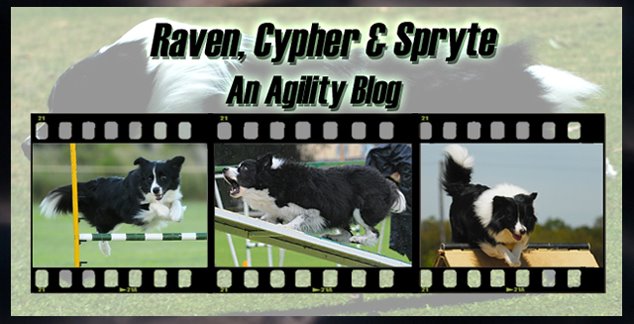




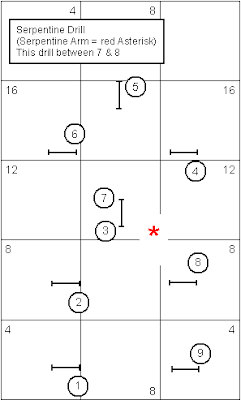

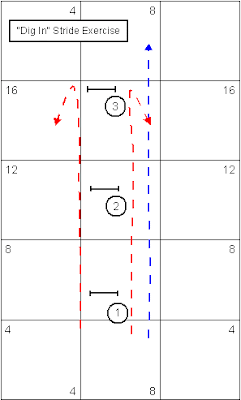


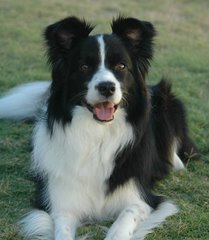
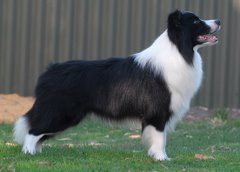

4 comments:
Wow! Thanks so much! Can't wait to set up the drills and see what you have in store for us, your readers, next!
Are you still planning on blogging about the Contacts and Weaves day with GD? Can't wait!
Great posts summarizing Greg's handling system. Just remember that there are many ways to skin a cat and for some dogs and handlers, some of Greg's stuff may just not work. Theoretically, it should, but the physical capabilities of the dog and handler play a big part in whether you can be successful with his system in it's entirety
I have no understanding of the active line and refusal line and how it can be used to determine when to RFP appropriately. I'm watching his 3rd video, and I still don't get it. I am hoping you can explain it to me!
Post a Comment